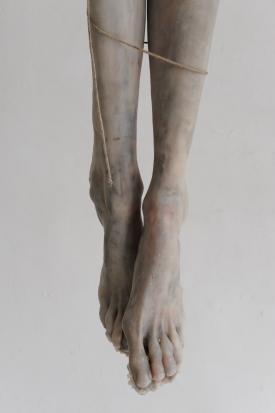In De Bruyckere’s oeuvre, humanity and the human condition take centre-stage. Her evocative visual language often conveys a fragile duality: suffering and love, sorrow and solace, life and death.
“It is the ever-recurring horror and beauty that we, as humans, do not fully understand, but of which we are nevertheless a part," says De Bruyckere. “My work is always a reflection of how I look at and question the world as a person and as an artist. This is also what appeals to me in Pasolini's work: everything we see is lived through, immortal and vibrates with the turmoil of the political, the erotic and the existential.”
De Bruyckere draws from a wide range of inspirations: religious iconography, classical mythology, the works of the Old Masters, and different cultural traditions. She brings these pillars of her visual language into a contemporary context—reflecting the violence that surrounds us, the images of human suffering on a global scale, but also beauty, solace, and transformation.
Khorós
In Khorós, Berlinde De Bruyckere engages in dialogue with kindred artists – her compagnons de route, as she calls them. The Greek Khorós (χορός) refers to the group of singers/dancers in Greek tragedies who comment on what is happening on-stage. The exhibition is thus conceived as an interplay of voices, shared themes and dialogues.
"Working in dialogue is what I love most," the artist admits. "Engaging with people, sensitive to what is going on around me. Rather than a ‘retrospective’, I found it compelling, at Bozar’s request, to reflect on past dialogues and the figures who have inspired me. My works—and their layers of meaning—are read differently in this context."
The dialogues in Khorós, much like De Bruyckere’s oeuvre itself, build bridges in time and space: from Greek mythology and Biblical scenes, via the cinema of Pier Paolo Pasolini, to the literary work of iconic musician and poet Patti Smith, or contemporary visual art, including by her partner, the artist Peter Buggenhout. Hindu ceremonial objects such as the Lingam and Yoni also engage in dialogue with De Bruyckere’s work, highlighting the explicitly erotic and sexually charged nature of some of her creations.
Alongside iconic works such as the horse (Lost I, 2006), the foal (Lost V, 2021–2022), and the monumental tree (San Sebastian, 2019-2022)—as well as pieces from the Venice Biennale (Arcangelo, City of Refuge, and Need-series) being shown in Brussels for the first time—Khorós also sheds light on lesser-known aspects of De Bruyckere’s practice. Recent creations, including her linoleum works (Plunder I, 2024-2025) and collages (It almost seemed a lily, 2024), have been specially produced for the Bozar exhibition.
Eros and Thanatos
Her corporeal, visceral sculptures dialogue with other art disciplines: painting, films, literature, video, dance.... In this cyclical exhibition, everything is intertwined, united by a recurring focus on the body in all its manifestations: its lust for life and its decline, in its eternal metamorphosis.
Weathered blankets, animal skins, trees, flowers, rusted metal, headless bodies—each form and material in De Bruyckere’s work is meticulously chosen for its metaphorical power. Moreover, she never works with new materials; the revaluation of what appears worthless or worn is fundamental to her artistic vision.
De Bruyckere: “My works compel you to look at something you might not want to see. I want to touch people where they are afraid to be touched, to address things they have no words for—yet there are always mitigating circumstances. I do not shy away from the wound; suffering, decay, death, loneliness—as much as they are part of life, they are part of my work. But the same goes for tenderness, connection, vitality, and desire. Eros and Thanatos, always side by side.”
In Khorós, highly intimate and fragile works contrast with monumental and raw installations. Yet each piece embodies a poetic vulnerability, inviting visitors to slow down and to reflect.
The exhibition is the first in the Conversation Pieces series, a new concept in which Bozar invites an artist to engage their own oeuvre in dialogue with the work of other artists.
Accompanying the exhibition is the publication Berlinde De Bruyckere. Khorós, published by Bozar Books & Mercatorfonds, featuring texts by, among others, Gary Carrion-Murayari.
The visitor guide—also accessible digitally via the Bloomberg Connects app—provides a narrative context for the works. Bozar is the first institution in Belgium to launch this app. In April, a free podcast based on conversations with the artist will also be released.
The exhibition is complemented by a cross-disciplinary programme featuring lectures and debates, the All over the P(a)lace nocturne, guided tours, film screenings (in the newly opened cinema room The 23), and a performance.

